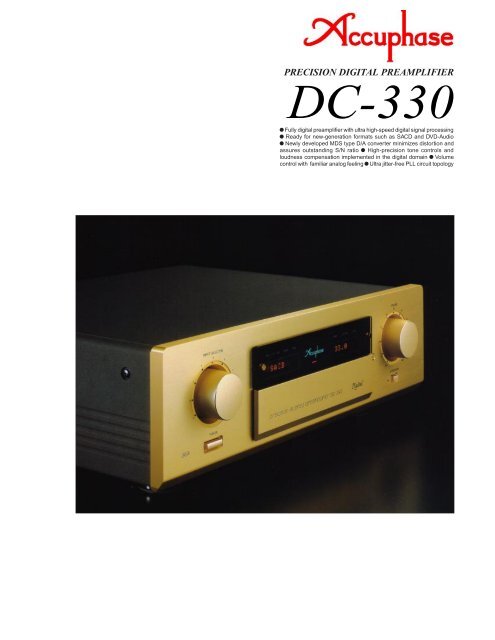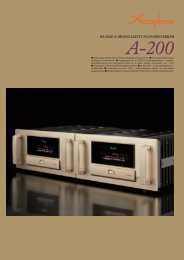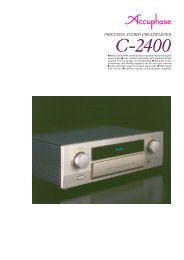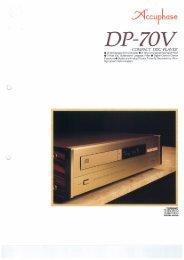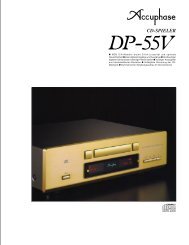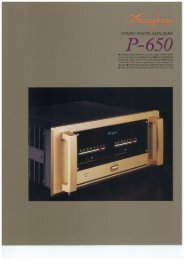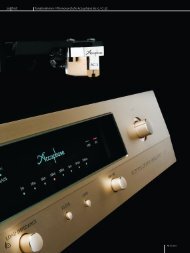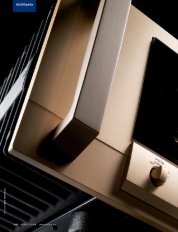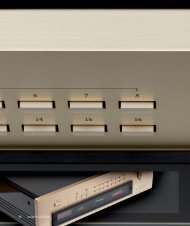You also want an ePaper? Increase the reach of your titles
YUMPU automatically turns print PDFs into web optimized ePapers that Google loves.
PRECISION DIGITAL PREAMPLIFIER<br />
<strong>DC</strong>-<strong>330</strong><br />
m Fully digital preamplifier with ultra high-speed digital signal processing<br />
m Ready for new-generation formats such as SACD and DVD-Audio<br />
m Newly developed MDS type D/A converter minimizes distortion and<br />
assures outstanding S/N ratio m High-precision tone controls and<br />
loudness compensation implemented in the digital domain m Volume<br />
control with familiar analog feeling m Ultra jitter-free PLL circuit topology
Leaving the analog/digital division far behind – this digital preamplifier<br />
features ultra high-speed DSP and complete readiness for the new<br />
generation of super high quality audio sources. The newly developed<br />
MDS (Multiple Delta Sigma) converter with 24-bit ultra high precision<br />
resolution results in dramatically enhanced performance. Witness a new<br />
dimension of audio perfection.<br />
The <strong>DC</strong>-<strong>330</strong> builds on the foundation of the<br />
<strong>DC</strong>-300, with some significant advantages over<br />
its predecessor. Ease of use has been further<br />
enhanced, and latest digital technology and<br />
redesigned circuitry assure total compatibility<br />
with the emerging new generation of top-quality<br />
audio sources such as SACD and DVD-Audio.<br />
The digital volume and tone controls function<br />
with previously unattainable precision, yet their<br />
smooth operation feel is on a par with the best<br />
of analog equipment. Internally, the <strong>DC</strong>-<strong>330</strong><br />
features ultra high-speed digital processing<br />
performed by a latest-generation DSP device.<br />
D/A conversion is handled by an innovative MDS<br />
(Multiple Delta Sigma) converter which boasts<br />
superior accuracy. This makes the <strong>DC</strong>-<strong>330</strong><br />
capable of bringing out the full potential of a<br />
new breed of audio sources that is just<br />
emerging, such as the Super Audio CD (SACD)<br />
and DVD-Audio. During the development of this<br />
amplifier, countless listening sessions were held<br />
to arrive at the detailed, rich sound that is a<br />
hallmark of every <strong>Accuphase</strong> product.<br />
In a preamplifier, the part that has a decisive<br />
influence on the sonic end result is the section<br />
where adjustments such as volume, tone, and<br />
loudness compensation are carried out. In the<br />
digital <strong>DC</strong>-<strong>330</strong>, this task is handled by an<br />
extremely fast DSP that assures a drastic leap<br />
in performance, achieving outstanding<br />
signal-to-noise ratio, amazing channel<br />
separation, and totally negligible distortion. The<br />
overall result is utterly natural and realistic sound<br />
with full control over every vital aspect.<br />
To provide complete flexibility with a view to<br />
future expansion, all inputs and recording<br />
Option<br />
Slot 8<br />
Analog Input<br />
AI2-U1<br />
Option<br />
Slot 7<br />
Digital<br />
Input/Output<br />
DIO-OC1<br />
Option<br />
Slot 6<br />
Option<br />
Slot 1<br />
External<br />
DSP<br />
Option<br />
(DIO-OC1)<br />
Volume<br />
Control<br />
Outputs<br />
Option<br />
(DIO-OC1)<br />
Left<br />
Right<br />
24-bit A/D<br />
Converter<br />
Coax<br />
RX<br />
Opto<br />
RX<br />
Coax<br />
Opto<br />
RX<br />
Coax<br />
Opto<br />
RX<br />
Coax<br />
RX<br />
Opto<br />
RX<br />
DAI<br />
Decoder<br />
Volume<br />
Volume<br />
Information<br />
DAI<br />
Encoder<br />
outputs of the <strong>DC</strong>-<strong>330</strong> are implemented as<br />
option boards. The option board slots support<br />
the ADB2 (<strong>Accuphase</strong> Digital Bus 2) interface<br />
which accommodates also formats such as<br />
SACD and DVD-Audio. The <strong>DC</strong>-<strong>330</strong> comes with<br />
a line input board for analog signals and a digital<br />
input/output board installed as standard<br />
equipment.<br />
As a perfect blend of analog operation feeling<br />
and sophisticated digital technology, the <strong>DC</strong>-<strong>330</strong><br />
transcends the mechanistic division of “analog”<br />
or “digital”, fusing them both into a higher<br />
dimension that is devoted solely to the<br />
enjoyment of music.<br />
Fully digital preamplifier with ultra<br />
high-speed DSP and support for high<br />
sampling rates: 2.8224 MHz/1-bit and 192<br />
kHz/24-bit.<br />
Figure 1 shows the block diagram of the <strong>DC</strong>-<strong>330</strong>.<br />
Digital sources are connected via coaxial or<br />
optical inputs located on option boards. All<br />
option board slots of the unit are ready to handle<br />
the bit stream output of a SACD player which<br />
uses 2.8224 MHz/1-bit,<br />
as well as the 192 kHz/<br />
24-bit signal used for<br />
DVD-Audio. Other<br />
high-quality formats that may emerge will also<br />
pose no problem to the <strong>DC</strong>-<strong>330</strong>. After the input,<br />
an ultra jitter-free PLL<br />
circuit extracts a<br />
high-precision<br />
reference signal totally<br />
free from the adverse<br />
Ultra<br />
Jitter-Free<br />
PLL<br />
Master<br />
Clock<br />
Digital<br />
Isolator<br />
DSP<br />
Tone Comp<br />
Mono Phase<br />
Digital<br />
Isolator<br />
Fig. 1 <strong>DC</strong>-<strong>330</strong> block diagram<br />
MDS 24-bit<br />
D/A Converter ×6<br />
∆Σ<br />
Digital Filter<br />
Volume<br />
Balance<br />
Attenuator<br />
MDS 24-bit<br />
D/A Converter ×6<br />
∆Σ<br />
Digital Filter<br />
Volume<br />
Balance<br />
Attenuator<br />
3-Pole<br />
Linear<br />
Phase<br />
Low Pass<br />
Filter<br />
Balanced<br />
Buffer<br />
3-Pole<br />
Linear<br />
Phase<br />
Low Pass<br />
Filter<br />
Balanced<br />
Buffer<br />
Unbalanced<br />
Outputs<br />
1<br />
effects of pulse transmission distortion and jitter.<br />
After conversion into the internal format of the<br />
<strong>DC</strong>-<strong>330</strong>, a DSP (Digital Signal Processor)<br />
operating at extremely high speed performs<br />
some of the<br />
major tasks that<br />
are handled by a<br />
preamplifier,<br />
such as tone<br />
control, loudness<br />
compensation,<br />
as well as mono<br />
and phase<br />
Ultra high-speed DSP<br />
switching. All of<br />
these adjustments are accomplished entirely in<br />
the digital domain.<br />
An ultra high-speed “isolated digital coupler”<br />
ensures effective electrical separation between<br />
the digital section encompassing the DSP and<br />
the D/A converter and subsequent analog<br />
segments of the amplifier. After digital volume,<br />
balance, and attenuation processing, the signal<br />
reaches the newly developed MDS type D/A<br />
converter which produces an analog signal of<br />
utmost precision. A 3-pole linear phase low-pass<br />
filter then removes any remnants of the digital<br />
process, before sending the signal to the<br />
balanced and unbalanced outputs.<br />
2<br />
1<br />
2<br />
Balanced<br />
Outputs<br />
Unbalanced<br />
Outputs<br />
1<br />
2<br />
1<br />
2<br />
Balanced<br />
Outputs<br />
Innovative MDS (Multiple Delta Sigma)<br />
converter reduces distortion to theoretical<br />
limits and assures outstanding S/N ratio<br />
The D/A converter which has considerable<br />
bearing on the sonic end result is a newly<br />
developed type that provides<br />
excellent performance in all aspects.<br />
The MDS (Multiple Delta Sigma)<br />
principle employs several delta sigma<br />
type converters in a parallel<br />
configuration which results in a<br />
drastic precision enhancement. The<br />
Left<br />
Analog<br />
Outputs<br />
Right<br />
Analog<br />
Outputs<br />
delta sigma principle combines<br />
oversampling with noise-shaping (a<br />
kind of digital feedback) which<br />
projects the amplitude information of<br />
the digital signal onto a time axis for<br />
precise conversion. Figure 2 shows<br />
several delta sigma converters which<br />
are fed with the same signal and<br />
whose outputs are combined to arrive<br />
at the overall waveform. In the<br />
<strong>DC</strong>-<strong>330</strong>, six delta sigma converters<br />
are operated<br />
in parallel,<br />
which results<br />
in a perform<br />
a n c e<br />
improvement<br />
by a factor of<br />
2.45 (=√6). An important<br />
characteristic of the MDS principle<br />
is that the performance benefits are<br />
achieved regardless of signal
n<br />
This photograph shows the <strong>DC</strong>-<strong>330</strong><br />
with separately available option boards<br />
installed and with the shielding cover<br />
removed.<br />
frequency and signal level. Therefore<br />
noise at very low signal levels that was<br />
difficult to contain with conventional delta<br />
Digital<br />
input<br />
DAC<br />
#1<br />
#2<br />
#1<br />
#n<br />
Signal<br />
Conversion error<br />
S1<br />
e1<br />
S2<br />
e2<br />
Sn-1<br />
en-1<br />
Sn<br />
en<br />
Fig. 2 MDS type D/A converter principle<br />
MDS<br />
output<br />
sigma converters now could be drastically<br />
reduced. The audible result is music<br />
reproduction emerging from utter silence with<br />
an impressive sense of clarity and nuance.<br />
Volume control with smooth analog feel<br />
A massive knob on a precision-machined shaft<br />
rotates a disc with star-shaped slits which<br />
S0<br />
e0<br />
generate a series of pulses in<br />
a phase detector. These<br />
pulses are utilized by a<br />
microprocessor to govern the<br />
volume control function. For the user,<br />
the volume control of the <strong>DC</strong>-<strong>330</strong> operates<br />
with a silky smooth and natural feel that perfectly<br />
matches the audible change in volume. The<br />
current volume setting is indicated by the<br />
numeric display and also by an array of LEDs<br />
on the circumference of the control. This lets<br />
you check the setting at a glance.<br />
Linear phase analog filters provide superior<br />
characteristics<br />
The analog filter, which serves to remove<br />
aliasing noise in the extreme upper frequency<br />
range, is a 3-pole linear phase type filter with<br />
outstanding phase characteristics. The cutoff<br />
frequency is optimized to minimize phase shift<br />
within the passband. Strict selection of all filter<br />
components assures sonic purity and total<br />
musical accuracy.<br />
D/A converter with printed circuit boards<br />
made from Teflon (glass fluorocarbon resin)<br />
with low dielectric constant and low loss<br />
The D/A converter boards use a substrate of<br />
n<br />
n<br />
PCB assembly with analog<br />
output connectors (balanced<br />
and unbalanced, 2 each) and<br />
MDS D/A converter (2 boards<br />
for left and right) using Teflon*<br />
(glass fluorocarbon resin)<br />
substrate with low dielectric<br />
constant and low loss.<br />
Supplied remote commander<br />
RC-24<br />
Allows input selection and<br />
adjustment of volume, tone<br />
control on/off, loudness compensator<br />
on/off, attenuator<br />
on/off, and other functions.<br />
glass fluorocarbon resin which has a stable, low<br />
dielectric constant as well as superior heat<br />
resistance and high-frequency characteristics.<br />
Using this material for the audio circuitry assures<br />
signal transmission with utmost purity, resulting<br />
in a clear improvement in perceived signalto-noise<br />
ratio. In the <strong>DC</strong>-<strong>330</strong>, gold-plated copper
super audio CD player DP-1000<br />
mmB compacr disc player DP-65V<br />
VOICING EQUALIZER<br />
MODEL DG-28<br />
MEMORY<br />
STEREO<br />
MHZ CH<br />
SELECTIVITY<br />
METER<br />
NORMAL SIGNAL POWER<br />
output level<br />
5<br />
4 6<br />
3<br />
9<br />
0 10<br />
2<br />
1<br />
7<br />
8<br />
model t-109<br />
fm stereo tuner<br />
@0 @1 @2 @3 @4 @5<br />
station<br />
STEREO<br />
SELECTIVITY<br />
NORMAL<br />
A<br />
B<br />
PRPGRAM<br />
C<br />
D<br />
MHZ<br />
METER<br />
SIGNAL<br />
DIGITAL<br />
FREQUENCY DIVIDNG<br />
NETWORK DF-35<br />
MEMORY<br />
CH<br />
INPUT LOCKED<br />
2<br />
1 3<br />
COAX<br />
4<br />
POWER<br />
FREQ<br />
LEVEL<br />
LEVEL<br />
FREQ<br />
MEMORY CHANEL EQUALIZER<br />
FUNCTION FUNCTION<br />
PUSH ENTER PUSH ENTER<br />
FUNCTION FUNCTION<br />
PUSH ENTER PUSH ENTER<br />
FUNCTION FUNCTION<br />
FUNCTION PUSH ENTER<br />
FUNCTION FUNCTION<br />
FUNCTION FUNCTION<br />
FUNCTION<br />
FUNCTION<br />
(PUSH ENTER)<br />
FUNCTION FUNCTION<br />
PUSH ENTER PUSH ENTER<br />
FUNCTION FUNCTION<br />
PUSH ENTER PUSH ENTER<br />
FUNCTION FUNCTION<br />
FUNCTION PUSH ENTER<br />
FUNCTION FUNCTION<br />
FUNCTION FUNCTION<br />
FUNCTION<br />
FUNCTION<br />
(PUSH ENTER)<br />
<strong>DC</strong>-<strong>330</strong> Application Examples (Option model names given in brackets.)<br />
Digital input<br />
✽ The digital input/output board (DIO-OC1) installed as<br />
standard equipment allows connection of a CD<br />
transport, or other digital devices, via coaxial cable (2<br />
connectors) or Toslink optical cable (2 connectors).<br />
✽ Option boards can be added for BNC (DI-BNC1), HPC<br />
optical cable (DIO-ST1), and HPC balanced cable<br />
(DIO-PRO1).<br />
SACD transport (DP-100) input<br />
✽ The HS-Link option board can be added for connection of<br />
the digital output of a SACD transport via dedicated cable.<br />
Digital recorder facilities<br />
✽ Standard equipment digital input/output board (DIO-<br />
OC1) allows connection of up to two digital recorders<br />
(DAT, MD, etc.) for recording and playback.<br />
✽ Option boards can be added for HPC optical cable (DIO-<br />
ST1) and AES/EBU standard digital input/output (DIO-<br />
PRO1).<br />
Analog line input<br />
✽ The line input board (AI2-U1) installed as standard<br />
equipment allows input of analog signals from a CD<br />
player, tuner, analog tape recorder or the analog output<br />
of a DAT, MD or similar recorder.<br />
✽ High-quality playback of analog output signals from<br />
SACD or DVD-Audio equipment possible (set AI2-U1,<br />
AI2-B1 to 96 kHz).<br />
✽ Addition of balanced input (AI2-B1) possible.<br />
Option board installation example (from left)<br />
l OPTION 8: Line Input Board (AI2-U1)<br />
l OPTION 7: Digital Input/Output Board (DIO-OC1)<br />
l OPTION 6: HPC Coaxial Input Board (DI-BNC1)<br />
l OPTION 5: Line Input/Output Board (AIO-U1)<br />
l OPTION 4, 3: Analog Disc Input Board (AI-AD1)<br />
l OPTION 2, 1: Balanced Input Board (AI2-B1)<br />
l EXT DSP: Digital Input/Output Board (DIO-OC1)<br />
l OUTPUTS: Digital Input/Output Board (DIO-OC1)<br />
Digital connection of CD transport,<br />
or similar<br />
DIGITAL OUT<br />
75-ohm coaxial cable BNC cable<br />
Analog connection of SACD<br />
player, DVD-Audio player,<br />
or similar<br />
ANALOG OUT<br />
Record player<br />
standard<br />
equipment<br />
optional<br />
LOW<br />
* For connection of digital equipment,<br />
75-ohm coaxial cable, Toslink optical fiber<br />
cable, HPC optical fiber cable, etc. can be<br />
used.<br />
* For analog input/output connections,<br />
audio cable with RCA plugs, balanced<br />
cables, etc. can be used.<br />
HIGH<br />
DIGITAL IN<br />
75-ohm<br />
coaxial cable<br />
To multi-amp system<br />
Digital Channel Divider<br />
DF-35<br />
Phono playback<br />
✽ The optional analog disc input board (AI-AD1) allows<br />
playback of analog records.<br />
✽ To implement dedicated inputs for MC and MM<br />
cartridges, install two boards.<br />
Analog recording<br />
✽ The line input/output board (AIO-U1) allows recording<br />
and playback with an analog tape recorder or an analog<br />
connection of a DAT, MD or similar recorder.<br />
✽ Optional unbalanced (AO-U1) or balanced (AO-B1)<br />
output boards provide dedicated high-quality signals<br />
for analog recording.<br />
DIGITAL IN<br />
Toslink optical<br />
fiber cable<br />
DIGITAL OUT<br />
75-ohm<br />
coaxial cable<br />
DIGITAL OUT<br />
DIGITAL IN<br />
EXT DSP connectors for DG-28<br />
✽ The digital input/output board (DIO-OC1 etc.) allows<br />
connection of digital audio equipment.<br />
✽ The Digital Voicing Equalizer DG-28 performs sound<br />
field compensation in the digital domain.<br />
OUTPUTS connector: DF-35 connection<br />
✽ The Digital output board (DIO-OC1 etc.) allows<br />
connection of digital audio equipment.<br />
✽ The Digital Channel Divider DF-35 allows volume<br />
control in the digital domain.<br />
CD-R, DAT, MD or other<br />
digital recorder<br />
LINE IN<br />
Tape recorder or other<br />
analog recording/playback<br />
component<br />
Digital Voicing Equalizer DG-28<br />
Tuner, CD player or other<br />
component with analog<br />
output<br />
ANALOG OUT<br />
Balanced<br />
cable<br />
Audio connecting cable<br />
with RCA plugs<br />
Power amplifier<br />
Analog outputs<br />
✽ Two sets of unbalanced and balanced output connectors<br />
are provided for power amplifier connection.<br />
traces further contribute to sonic purity.<br />
* Teflon is a registered trademark of DuPont USA.<br />
Ultra Jitter-Free PLL Circuit<br />
For the purpose of synchronizing operation of<br />
the D/A converter with the digital audio interface<br />
(DAI), a phase-locked loop (PLL) circuit is used<br />
which generates a master clock to be used as<br />
system reference. As shown in the diagram, the<br />
Ultra Jitter-Free PLL Circuit of the <strong>DC</strong>-<strong>330</strong><br />
consists of a preamble detector and a<br />
DAI input signal<br />
Fig. 3<br />
Preamble<br />
detector Preamble signal<br />
(pulse distortion removed)<br />
Phase<br />
comparator<br />
Frequency<br />
divider<br />
Loop<br />
filter<br />
VCO<br />
Master clock output<br />
(free from jitter and<br />
pulse distortion)<br />
Ultra jitter-free PLL circuit<br />
voltage-controlled oscillator (VCO) using a<br />
quartz crystal element. The master clock<br />
produced by this PLL circuit is totally free from<br />
the effects of pulse distortion and jitter.<br />
Perfect separation of digital and analog<br />
sections totally shuts out noise<br />
Ultra-high speed isolated digital couplers rated<br />
for 80 MBPS are used to<br />
isolate the digital and<br />
analog sections of the<br />
<strong>DC</strong>-<strong>330</strong>. This ensures that<br />
the signal is transmitted<br />
faithfully, while noise is<br />
totally shut out, thus<br />
preserving the superior<br />
sonic transparency that is a hallmark of the<br />
<strong>DC</strong>-<strong>330</strong>.
OPTION BOARDS<br />
<strong>Accuphase</strong> offers a wide range of digital and analog input and output boards which can be installed in<br />
the option board slots on the unit. This allows the user to configure the system to fit any need.<br />
l All option boards designed for the <strong>DC</strong>-300, DP-75V, DG-28, DF-35, etc. can be used.<br />
l When an option board has been installed and is selected, the input is shown on the alphanumeric display.<br />
l The name shown for an input can be customized.<br />
Digital Boards<br />
For BNC coaxial cable input<br />
HPC Coaxial Input Board DI-BNC1<br />
Allows connection of coaxial cable with 75-ohm BNC connector.<br />
Guaranteed specifications<br />
l Digital input: 0.5 Vp-p, 75 ohms<br />
For HPC optical fiber cable input/output<br />
HPC Optical Input/Output Board DIO-ST1<br />
Allows connection of an ST type optical link.<br />
Designed for an ultra high-speed link with a transfer rate of 150 MBPS.<br />
✽ HPC optical fiber cables (HLG-10 etc.) are available from <strong>Accuphase</strong>.<br />
Guaranteed specifications<br />
l Optical input: -30 to -10 dBm<br />
l Optical output: -19 to -14 dBm<br />
For additional digital input/output<br />
Digital Input/Output Board DIO-OC1<br />
Provides two sets of coaxial and optical connectors, for recording/playback with<br />
two digital recorders.<br />
COAXIAL: for 75-ohm coaxial cable<br />
OPTICAL: for Toslink optical fiber cable<br />
✽ One DIO-OC1 board is installed as standard equipment in the OPTION 7<br />
slot.<br />
For professional-standard input/output<br />
AES/EBU Input/Output Board DIO-PRO1<br />
Provides a set of XLR input and output connectors conforming to AES/EBU<br />
professional digital standards.<br />
Can be used to accept the output signal from a digital component or to perform<br />
playback and recording with a digital recorder having the same type of connectors.<br />
✽ HPC balanced cables (HLC-10 etc.) are available from <strong>Accuphase</strong>.<br />
Analog Boards<br />
✽ Analog input signals are converted to digital signals by an on-board A/D converter. ✽ Digital output signals are converted to analog signals by an on-board D/A converter.<br />
✽ The AI-U1, AI-B1 can also be used.<br />
For playback of analog source equipment<br />
Line Input Board AI2-U1<br />
Provides a conventional unbalanced high-level input for the analog output signal<br />
from a CD player, tuner, tape recorder or similar component.<br />
✽ One AI2-U1 board is installed as standard equipment in the OPTION 8<br />
slot.<br />
✽ The sampling frequency can be switched between 48 and 96 kHz.<br />
✽ Incorporates a 96 kHz/24-bit delta sigma type A/D converter.<br />
For playback of analog records<br />
Analog Disc Input Board AI-AD1<br />
Incorporates a high-performance, high-gain phono equalizer for playback of<br />
analog (phono) records.<br />
✽ Incorporates a 20-bit, 5-pole delta sigma A/D converter with 64-times<br />
oversampling.<br />
✽ On-board controls for MM/MC switching and subsonic filter switching<br />
[MM] gain: 30 dB, input impedance 47 kilohms<br />
[MC] gain: 60 dB, input impedance 100 ohms<br />
For analog playback of equipment with balanced output<br />
Balanced Input Board AI2-B1<br />
Provides a conventional balanced high-level input for the analog signal from a<br />
CD player, tuner, recorder or similar component with balanced analog output.<br />
✽ The sampling frequency can be switched between 48 and 96 kHz.<br />
✽ Incorporates a 96 kHz/24-bit delta sigma type A/D converter.<br />
For analog recording and playback<br />
Line Input/Output Board AIO-U1<br />
Provides analog inputs and outputs for use with a tape recorder.<br />
✽ Incorporates an 18-bit, 4-pole delta sigma A/D converter with 64-times<br />
oversampling.<br />
✽ Incorporates an 18-bit, 4-pole delta sigma D/A converter with 64-times<br />
oversampling.<br />
(The signal chosen with the Input Selector is converted to analog and<br />
output via this board.)<br />
For high-quality analog recording<br />
Line Output Board AO-U1<br />
Provides analog recording output for use with a tape recorder or the analog<br />
input of a DAT, MD or other recorder.<br />
✽ The signal chosen with the Rec Selector is converted to analog and output<br />
via this board.<br />
l D/A converter: 20-bit, 4 MMB principle<br />
l Digital filter: 20-bit, 8-times oversampling<br />
For analog recording on equipment with balanced input<br />
Balanced Output Board AO-B1<br />
Provides an analog recording output for a recorder with balanced input.<br />
✽ The signal chosen with the Rec Selector is converted to analog and output<br />
via this board.<br />
l D/A converter: 20-bit, 4 MMB principle<br />
l Digital filter: 20-bit, 8-times oversampling<br />
Slots for up to 10 option boards allow<br />
matching to any input and recording output<br />
configuration<br />
All inputs and recording outputs of the <strong>DC</strong>-<strong>330</strong><br />
are implemented as option boards. All option<br />
board slots support the ADB2 interface standard<br />
that makes the unit ready to handle the next<br />
generation of audio sources, such as SACD and<br />
DVD-Audio.<br />
l For digital input/output, one option board DIO-OC1 with<br />
optical and coaxial connectors is installed as standard<br />
equipment. Other available boards include BNC, HPC<br />
optical cable (ST), and HPC balanced input.<br />
l The HS (High Speed) Link option board can be installed<br />
for connection of the SACD transport DP-100.<br />
l For analog input, one option board, AI2-U1, with a highprecision<br />
96 kHz/24-bit delta sigma A/D converter is<br />
installed as standard equipment. Playback of analog<br />
records is also possible with a separate option board.<br />
l The EXT DSP option board slot allows connection of the<br />
Digital Voicing Equalizer DG-28.<br />
l The Digital Channel Divider DF-35 can be connected to<br />
a digital output board installed in the OUTPUTS slot,<br />
allowing digital volume control.<br />
ADB 2: <strong>Accuphase</strong> Digital Bus 2<br />
Interface standard supporting also high<br />
sampling rates above 48 kHz, such as used<br />
by SACD and DVD-Audio.
Ultra high-speed DSP achieves highprecision,<br />
high-quality tone control and<br />
loudness compensation<br />
Because the signal is being processed entirely<br />
in the digital domain, frequency response<br />
n DAI, DSP assembly<br />
Contains DAI encoder/decoder, ultra jitter-free<br />
PLL circuit, and DSP for tone control/<br />
compensator signal processing.<br />
adjustments are possible without any alteration<br />
of circuit impedance. For the listener, this means<br />
that sonic realism and imaging are maintained<br />
regardless of the control setting.<br />
Outstanding S/N ratio and channel<br />
separation<br />
The digital volume control of the <strong>DC</strong>-<strong>330</strong><br />
introduces no quality deterioration regardless<br />
of the level setting, resulting in outstanding<br />
perceived signal-to-noise ratio. Digital<br />
processing also completely eliminates the<br />
problem of inter-channel crosstalk.<br />
User-editable alphanumeric input position<br />
indication<br />
When the input selector is operated, input<br />
sources are shown on<br />
the display of the<br />
<strong>DC</strong>-<strong>330</strong> using alphanumeric<br />
characters. If<br />
desired, any position can be renamed, using a<br />
choice of 96 characters and symbols. A large<br />
number of ready-made names such as SACD,<br />
DVD, CD, MD, etc. are also available.<br />
Fully balanced analog output circuitry<br />
The analog output section features completely<br />
balanced circuitry which is isolated from the<br />
ground line. Two sets of balanced XLR<br />
connectors and unbalanced RCA-type phono<br />
connectors accommodate any system<br />
requirements.<br />
n FRONT PANEL<br />
n REAR PANEL<br />
A B C D<br />
F G H I J K L M N<br />
Line input board installed as standard equipment<br />
Digital input/output board installed as standard equipment<br />
Option board slots<br />
A Input selector<br />
B BASS/TREBLE controls<br />
C Loudness compensator selector<br />
D Balance control<br />
E Volume control<br />
F Power switch<br />
G Output ON/OFF button<br />
H Phase selector button<br />
I Mono/stereo selector button<br />
J Tone control ON/OFF button<br />
K Loudness compensator ON/OFF button<br />
L External digital equipment ON/OFF button<br />
M Display mode/edit buttons<br />
N Attenuator buttons<br />
O Analog output connectors<br />
(Unbalanced, balanced; 2 each)<br />
P AC outlets H<br />
Q AC input connector (for supplied power cord) H<br />
n Optional cables (available in 2 m, 3 m, and 5 m lengths)<br />
l HPC optical fiber (ST) HLG-10 (1 m)<br />
l HPC balanced cable HLC-10 (1 m)<br />
l Toslink optical fiber LG-10 (1 m)<br />
<strong>DC</strong>-<strong>330</strong> Guaranteed Specifications<br />
[Guaranteed specifications are measured according to EIAJ standard CPR-2101]<br />
l Input format: Quantization bits: 16 to 24 bits, linear<br />
(EIAJ CP-1201 standard format) Sampling frequency (auto detect):<br />
32 kHz, 44.1 kHz, 48 kHz, 88.2 kHz, 96 kHz,<br />
176.4 kHz, 192 kHz, 2,8224 MHz<br />
[implemented as option board]<br />
l Digital input format level Format: Digital audio interface<br />
(EIAJ CP-1201)<br />
OPTICAL: Optical input, –27 to –15 dBm<br />
COAXIAL: 0.5 Vp-p, 75 ohms<br />
[implemented as option board]<br />
l Digital output format level Format: Digital audio interface<br />
(EIAJ CP-1201)<br />
OPTICAL: Optical output, –21 to –15 dBm<br />
Wavelength, 660 nm<br />
COAXIAL: 0.5 Vp-p at 75 ohms<br />
[implemented as option board]<br />
l Frequency characteristics 0.5 to 50,000 Hz +0, –3 dB<br />
l D/A converter<br />
24-bit MDS converter<br />
l Total harmonic distortion 0.0006% (20 to 20,000 Hz)<br />
l Signal-to-noise ratio 120 dB<br />
l Dynamic range<br />
112 dB (24-bit input, low-pass filter off)<br />
l Channel separation<br />
106 dB<br />
l Output voltage and impedance BALANCED: 5 V at 50 ohms, balanced XLR type<br />
(DSP)<br />
UNBALANCED: 5 V at 50 ohms, RCA phono jack<br />
l Volume control<br />
(DSP)<br />
Linear mode: – , 0.5 to 99.5<br />
(in 0.5 steps), Max.<br />
dB mode: – , –94.0 to +12.0 dB,<br />
Speed-sensing principle<br />
l Balance control<br />
Left/right level difference:<br />
(DSP)<br />
– , –4 to 0 dB (in 1 dB steps)<br />
l Tone control<br />
Crossover frequency and adjustment range<br />
(DSP)<br />
Bass: 315 Hz ±5 dB (50 Hz), 1 dB steps<br />
Treble: 3.15 kHz ±5 dB (20 kHz), 1 dB steps<br />
l Loudness compensator 1: +3 dB (100 Hz)<br />
(DSP)<br />
2: +6 dB (100 Hz)<br />
3: +6 dB (100 Hz), +3 dB (20 kHz)<br />
4: +9 dB (100 Hz)<br />
5: +9 dB (100 Hz), +6 dB (20 kHz)<br />
l Attenuator (DSP)<br />
–20 dB<br />
l Power requirements<br />
120 V / 230 V (Voltage as indicated on rear panel), 50/60 Hz<br />
l Power consumption 25 W<br />
l Maximum dimensions Width 475 mm (18-11/16” )<br />
Height 150 mm (5-7/8” )<br />
Depth 412 mm (16-1/4”)<br />
l Weight<br />
20.2 kg (44.5 lbs) net<br />
25.2 kg (55.6 lbs) in shipping carton<br />
l Supplied Remote Commander Remote control system: Infrared pulse<br />
RC-24<br />
Power requirements: 3 V <strong>DC</strong>, IEC R03<br />
(size AAA) batteries × 2<br />
Dimensions: (W×H×D) 66 mm × 175 mm × 20 mm<br />
Remarks<br />
Weight:<br />
220 g (including batteries)<br />
H This product is available in versions for 120/230 V AC. Make sure that the voltage shown on the rear panel matches the AC line voltage in your area.<br />
H The shape of the AC inlet, plug of the supplied power cord, and AC outlet depends on the voltage rating and destination country.<br />
H These unswitched AC outlets may not be supplied depending on the safety standards or regulations applicable in the particular country to where the unit is destined.<br />
n Supplied accessories l AC power cord<br />
l 75-ohm coaxial cable (DL-15)<br />
l Audio cable with RCA plugs<br />
l Remote Commander RC-24<br />
E<br />
O P (<br />
OUTPUTS: option board slot for connection of DF-35<br />
EXT DSP: option board slot for connection of DG-28<br />
Q (<br />
m<br />
Specifications and design subject to change without notice for improvements.<br />
PRINTED IN JAPAN<br />
K9910 851-0164-00 (AD1)


